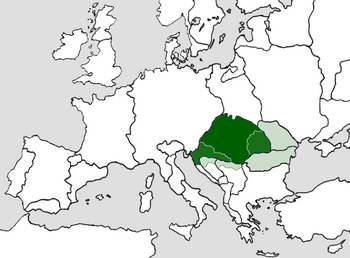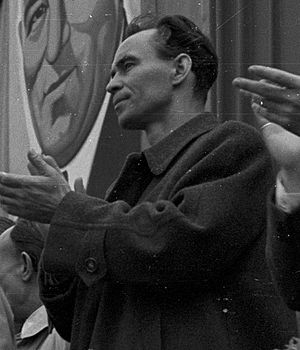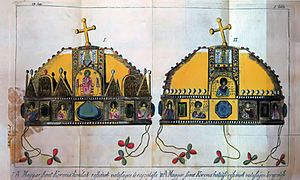Kingdom of Hungary facts for kids
Quick facts for kids
Kingdom of Hungary
Magyar Királyság
|
|||||||||||||||||
|---|---|---|---|---|---|---|---|---|---|---|---|---|---|---|---|---|---|
| 1000—1918 1919—1944 1944—1946 |
|||||||||||||||||
|
|
|||||||||||||||||

Territory of the Kingdom of Hungary
|
|||||||||||||||||
| Capital | Esztergom; Fehérvár; Buda; Pozsony; Debrecen; Budapest |
||||||||||||||||
| Government | Monarchy | ||||||||||||||||
| Monarch | |||||||||||||||||
|
• 1000-1038
|
Stephen I of Hungary | ||||||||||||||||
|
• 1916-1918
|
Charles I of Austria | ||||||||||||||||
| History | |||||||||||||||||
|
• Coronation of Stephen I of Hungary
|
1000 | ||||||||||||||||
|
• Act I/1946
|
1946 | ||||||||||||||||
| ISO 3166 code | HU | ||||||||||||||||
|
|||||||||||||||||
The Kingdom of Hungary was a powerful monarchy in Central Europe. It existed for a very long time, from the Middle Ages (around the year 1000) until the 20th century (1946).
Hungary started as a Christian kingdom when its first king, Stephen I, was crowned in Esztergom around the year 1000. His family, the Árpád dynasty, ruled for 300 years. By the 12th century, Hungary became an important country in Europe.
In the 16th century, the Ottoman Empire took over parts of central and southern Hungary. This split the country into three areas:
- The Habsburg Royal Hungary
- Ottoman Hungary (ruled by the Ottomans)
- The semi-independent Principality of Transylvania
The House of Habsburg (a powerful European royal family) ruled Hungary after the Battle of Mohács until 1918. They also helped free Hungary from Ottoman rule.
From 1867, Hungarian lands became part of Austria-Hungary. This was known as the Lands of the Crown of Saint Stephen. The monarchy ended in 1918 when the last king, Charles IV, was removed from power. Hungary then became a republic.
The kingdom was brought back in name from 1920 to 1946, during a time called the "Regency". However, it truly ended when the Soviet Union took control in 1946.
The Kingdom of Hungary was home to many different groups of people. It included areas that are now Hungary, Poland, Slovakia, Transylvania (part of Romania), Carpathian Ruthenia (part of Ukraine), Vojvodina (part of Serbia), and Burgenland (part of Austria). From 1102, it also included Croatia, which was united with Hungary under the same king.
Today, August 20th is a national holiday in Hungary. It celebrates the founding of the state by King Stephen I.
From Kingdom to Republic

After the Soviet Union took over Hungary in 1944, they set up strict rules. They took important resources and controlled Hungary's internal affairs. The Soviet Red Army created police groups to target people they called "class enemies."
The Soviets thought poor Hungarians would support the communists in elections. However, the communists did not win many votes. A coalition government was formed, led by Prime Minister Zoltán Tildy.
Despite this, the Soviets interfered. They made sure communists got important government jobs. They also put in place harsh rules and punishments. In 1945, Soviet Marshal Kliment Voroshilov forced the Hungarian government to give the Interior Ministry to a communist.
The new Communist Interior Minister, László Rajk, created the ÁVH secret police. This police force stopped political opposition. They used threats, false accusations, imprisonment, and torture.
In 1946, Hungary's government changed to a republic. The monarchy was officially ended. Soon after, the Soviet Union pushed Hungarian leader Mátyás Rákosi to start a "more intense class struggle." This led to Hungary becoming a communist state.
This communist rule lasted until October 23, 1956. On that day, the Hungarian uprising began. The uprising was successful for a short time, until November 10, 1956. Soviet occupation was then restored and lasted until 1989. In 1989, the communists agreed to give up their power. This led to free elections in March 1990.
Today, Hungary is a free republic. People see the Kingdom of Hungary as an important part of the country's history. This connection to the past is shown in Hungary's national symbols. The Holy Crown of Hungary and the Coat of arms of Hungary are the same as they were during the monarchy. Many holidays, the official language (Hungarian), and the capital city Budapest have also stayed the same. In 2000, Hungary celebrated 1000 years since its founding.
Images for kids
-
King Stephen I of Hungary
-
The Holy Crown of Hungary along with other regalia
-
Louis I of Hungary on Heroes Square, Budapest
-
King Sigismund of Hungary
-
Renaissance portrait of Matthias Corvinus, King of Hungary, (marble relief by Giovanni Dalmata (attributed to), Benedetto da Maiano (previous attribution) 1476)
-
Western conquests of Matthias Corvinus
-
Ethnic map of the Hungary proper publicized by the Hungarian Trianon delegation. Regions with population density below 20 persons/km2 are left blank and the corresponding population is represented in the nearest region with population density above that limit. The vibrant, dominant red color was deliberately chosen to mark Hungarians while the light purple color of the Romanians, who were already the majority in the whole of Transylvania back then, is shadow-like. Hungarians Germans Slovaks Ruthenians Romanians Serbs Croats Spaces with a smaller density than 20 persons/sq km
-
Coronation of Francis Joseph I and Elisabeth at Matthias Church, Buda, 8 June 1867
-
The Treaty of Trianon: Hungary lost 72% of its territory, its sea access, half of its 10 biggest cities and all of its precious metal mines; 3,425,000 ethnic Hungarians found themselves separated from their motherland.
-
Miklós Horthy was regent of Hungary from 1920 to 1944
-
István Bethlen, the Prime Minister of Hungary
See also
 In Spanish: Reino de Hungría para niños
In Spanish: Reino de Hungría para niños





















